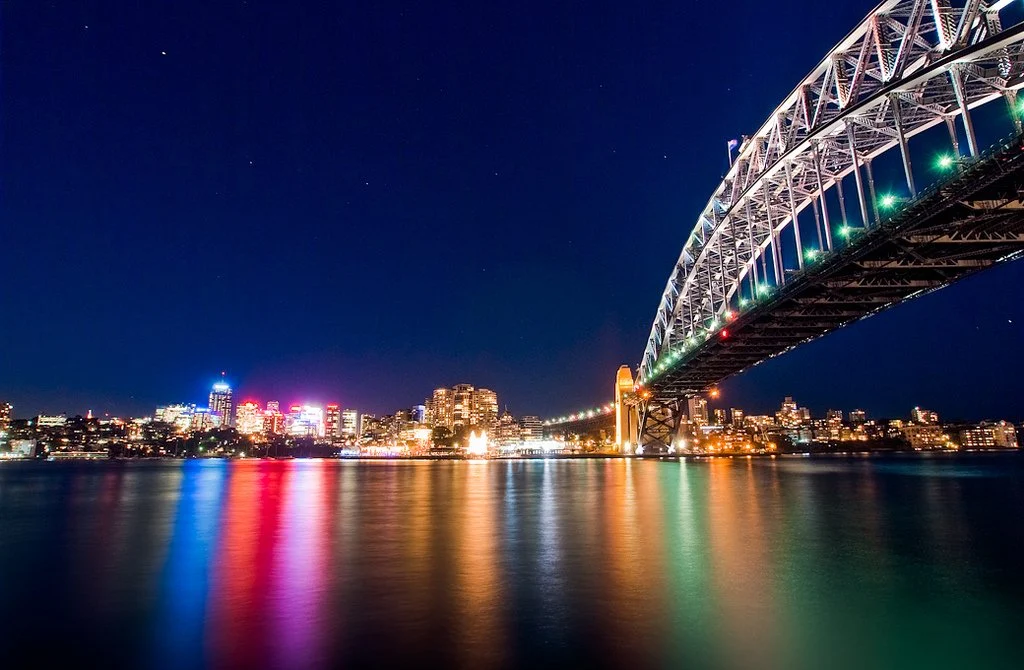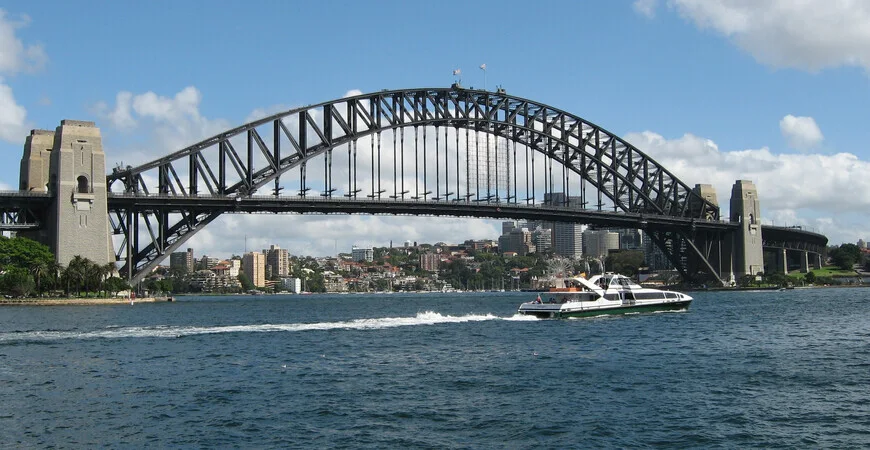Sydney Harbour Bridge is the largest bridge in Sydney, one of the largest steel arch bridges in the world. It is one of the main attractions of Sydney. The Australians jokingly call the bridge a “hanger” because of its unusual shape.
 |
| Sydney Harbour Bridge |
General Information
The arched span of the Sydney Harbour Bridge is 503 meters long. This is slightly less than the 518-meter span of the longest steel arch bridge, Fayetteville, across the gorge through which the New River flows in the US state of West Virginia. Since at present, if it is necessary to build a bridge with a long span, a suspension or cable-stayed bridge scheme is chosen, since they are much lighter and cheaper than a rigid arch bridge, the Harbour Bridge will for a long time top the list of the largest arch bridges in the world.
 |
| Sydney Harbour Bridge |
The steel arch of the Harbour Bridge weighs 39,000 tons. It rises to 139 meters above sea level and at the same time has a clearance of 49 meters above the water surface of the bay, which ensures the passage of any marine vessels under the bridge. Interestingly, the height of the arch can increase by about 18 cm on hot days due to the fact that the metal expands when heated.
The total length of the entire bridge is 1,149 meters. Its width is 49 meters, and the total weight of the bridge is as much as 52,800 tons! The steel structural members of the bridge are connected by six million rivets.
 |
| Sydney Harbour Bridge |
Tourists
Since October 1, 1998, excursions for people over 10 years old have been carried out on the bridge - climbing along the side arch of the bridge to its top, from where a breathtaking panorama of the city opens. To climb, tourists will need rubber-soled shoes and a special suit with insurance, which is issued on the spot. An accompanying instructor will help you with all the difficulties.
Those planning to visit Sydney at the end of December should remember that the Harbour Bridge is an important part of the New Year's celebrations and is used for spectacular pyrotechnic shows. The first so-called “family” fireworks display at 9 pm attracts a large number of families with small children. The second, main fireworks display starts at midnight. The idea for fireworks came about after the centenary celebrations of the Brooklyn Bridge in 1983. In 1986, pyrotechnician Sid Howard first realized this idea during the celebration of the 75th anniversary of the Australian Navy.. Since 1999, vibrant pyrotechnic shows have been held annually, with each subsequent year having a different theme. Fireworks attract a large number of residents and visitors to Sydney, as well as television viewers around the world. So the New Year's show of 2010-2011 was watched by one and a half million viewers and 1.1 billion viewers!
 |
| Sydney Harbour Bridge |
Construction History
Prior to the construction of the Sydney Harbour Bridge, the northern part of the city on the left bank of the Paramata River at its mouth was virtually isolated from the city center. Communication was carried out along a long railway line, or along a highway with five bridges.
The plan to build a bridge between Davis Point and Wilson Point originated in the middle of the 19th century. Over the next 50 years, 24 bridge projects and one tunnel project were proposed, but upon careful consideration in 1904, all of them were rejected.
Then the Australian John Job Crew Bradfield, the chief engineer of the Public Works Administration, took up the development of the project. He was the author of preliminary recommendations, on the basis of which the specifications for the 1922 International Competition for Arch Bridges with Granite Shore Abutments were prepared. The victory was won by the design of the London engineer Sir Ralph Freeman of Dorman Long. Construction, overseen by Bradfield, began in 1926 and was completed six years later.
 |
| Sydney Harbour Bridge |
The construction of the bridge turned out to be the most difficult task from a technical and organizational point of view. In order not to disturb the functioning of the port, it was decided to use the cantilever technique, moving from the supports towards the central part. The strength test of the bridge was carried out in February 1932 with the help of 96 locomotives.
So, in 1932, the Sydney Harbour Bridge was opened, and by the time the construction was completed, it cost $ 20 million.
Today, motorists moving into Sydney South pay a $2 toll to cover the cost of maintaining the bridge. The bridge pylon closest to the Sydney Opera House is open to the public. The observation deck offers a panoramic panorama of Sydney, this is an ideal place for photo and video filming.
